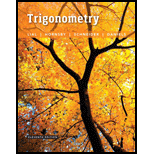
Concept explainers
(a)
To calculate: The pollution levels on January 1, base year by using the information given below:
The pollution level in a certain area might be given by the
where x is the time in years, with
(b)
To calculate: The pollution levels on July 1, base year by using the information given below:
The pollution level in a certain area might be given by the function
where x is the time in years, with
(c)
To calculate: The pollution levels on January 1, following year by using the information given below:
The pollution level in a certain area might be given by the function
where x is the time in years, with
(d)
To calculate: The pollution levels on July 1, following year by using the information given below:
The pollution level in a certain area might be given by the function
where x is the time in years, with
Want to see the full answer?
Check out a sample textbook solution
Chapter 4 Solutions
Trigonometry (11th Edition)
- Aloha Airlines Flight 007 is flying due east but finds it necessary to detour around a group of thundershowers. The plane 1st turns at a bearing of N 73° E, flies for a while, then 2nd turns to intercept the original path and travels for 50 km at a bearing of S 41° E, back to the original path. As stated the plane traveled 50 km in the 2nd leg of the journey getting back to the path. How far did the plane travel in the 1st leg of the journey?arrow_forwardQuestion 6 Aloha Airlines Flight 007 is flying due east but finds it necessary to detour around a group of thundershowers. The plane 1st turns at a bearing of N 73° E, flies for a while, then 2nd turns to intercept the original path and travels for 50 km at a bearing of S 41° E, back to the original path. As stated the plane traveled 50 km in the 2nd leg of the journey getting back to the path. How far did the plane travel in the 1st leg of the journey? Question Help: Video Submit Question Jump to Answer P3 E E T Q Search L W F1 % R R FS F € t X C V 08 7 47 * B FB Y I E 7 コ コ I Barrow_forwardSaved Tempo Company's fixed budget (based on sales of 18,000 units) folllows Fixed Budget Sales (18,000 units x $201 per unit) 3,618,000 Costs Direct materials Direct labor Indirect materials Supervisor salary 432,000 792,000 486,000 232,000 Sales commissions 126,000 Shipping 270,000 Administrative salaries 232,000 Depreciation-office equipment 252,000 Insurance 222,000 Office rent 232,000 Income 292,000 1. Compute total variable cost per unit. 2. Compute total fixed costs 3. Prepare a flexible budget at activity levels of 16,000 units and 20,000 units. Complete this question by entering your answers in the tabs below. Q Search hp PRES 0 Oarrow_forward
- Find PS. P 76° e S Type your answer... 39 28°arrow_forwardWed Mar 26 13 14 Quiz E Finding Missing Sides and Angle Practice Numeric 2 points Find PS. P Q 39 R 28° 76° 13 S Numeric 2 points Find the measure of angle CDB. Rarrow_forwardThe difference in length of a spring on a pogo stick from its non-compressed length when a teenager is jumping on it after θ seconds can be described by the function f(θ) = 2sinθ + √2.Part A: Determine all values where the pogo stick's spring will be equal to its non-compressed length. Part B: If the angle was doubled, that is θ became 2θ, what are the solutions in the interval [0, 2π)? How do these compare to the original function?Part C: A toddler is jumping on another pogo stick whose length of its spring can be represented by the function g(θ) = 1 cos^2θ + √2. At what times are the springs from the original pogo stick and the toddler's pogo stick lengths equal?arrow_forward
- Students were asked to prove the identity (sec x)(csc x) = cot x + tan x. Two students' work is given.Student AStep 1:1/Cos x * 1/sin x = cot x + tan xStep 2: 1/cos x sin x = cot x + tan xStep 3: (cos^2 x + sin^2 x)/cos x sin x = cot x + tan xStep 4: cos^2 x/cos x sin x + sin^2x/cos x sin x= cot x + tan xStep 5: cos x/sin x + sin x/cos x = cot x + tan xStep 6: cot x + tan x = cot x + tan xStudent BStep 1: sec x csc x = cos x/ sin xStep 2: sec x csc x = cos^2x/cos x sin x + sin^2x/cos x sin xStep 3: sec x csc x = cos^2x + sin^2x/cos x sin xStep 4: sec x csc x = 1/cos x sin xStep 5: sec x csc x = (1/cos x), (1/sin x)Step 6: sec x csc x = sec x csc xPart A: Did either student verify the identity properly? Explain why or why not. Part B: Name two identities that were used in Student A's verification and the steps they appear in.arrow_forwardLet sinθ = 2√2/5 and π/2 < θ < πPart A: Determine the exact value of cos 2θ.Part B: Determine the exact value of sin(θ/2)arrow_forward1. Find the solution set of In(x) sin(x) ≤ 0, for x = [0,14].arrow_forward
 Trigonometry (MindTap Course List)TrigonometryISBN:9781337278461Author:Ron LarsonPublisher:Cengage Learning
Trigonometry (MindTap Course List)TrigonometryISBN:9781337278461Author:Ron LarsonPublisher:Cengage Learning

 College Algebra (MindTap Course List)AlgebraISBN:9781305652231Author:R. David Gustafson, Jeff HughesPublisher:Cengage Learning
College Algebra (MindTap Course List)AlgebraISBN:9781305652231Author:R. David Gustafson, Jeff HughesPublisher:Cengage Learning College AlgebraAlgebraISBN:9781305115545Author:James Stewart, Lothar Redlin, Saleem WatsonPublisher:Cengage LearningAlgebra & Trigonometry with Analytic GeometryAlgebraISBN:9781133382119Author:SwokowskiPublisher:Cengage
College AlgebraAlgebraISBN:9781305115545Author:James Stewart, Lothar Redlin, Saleem WatsonPublisher:Cengage LearningAlgebra & Trigonometry with Analytic GeometryAlgebraISBN:9781133382119Author:SwokowskiPublisher:Cengage





